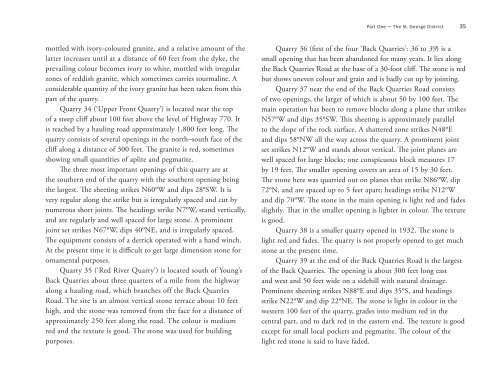The Granite Industry of Southwestern New Brunswick: A Historical ...
The Granite Industry of Southwestern New Brunswick: A Historical ...
The Granite Industry of Southwestern New Brunswick: A Historical ...
Create successful ePaper yourself
Turn your PDF publications into a flip-book with our unique Google optimized e-Paper software.
Part One — <strong>The</strong> St. George District 35<br />
mottled with ivory-coloured granite, and a relative amount <strong>of</strong> the<br />
latter increases until at a distance <strong>of</strong> 60 feet from the dyke, the<br />
prevailing colour becomes ivory to white, mottled with irregular<br />
zones <strong>of</strong> reddish granite, which sometimes carries tourmaline. A<br />
considerable quantity <strong>of</strong> the ivory granite has been taken from this<br />
part <strong>of</strong> the quarry.<br />
Quarry 34 (‘Upper Front Quarry’) is located near the top<br />
<strong>of</strong> a steep cliff about 100 feet above the level <strong>of</strong> Highway 770. It<br />
is reached by a hauling road approximately 1,800 feet long. <strong>The</strong><br />
quarry consists <strong>of</strong> several openings in the north–south face <strong>of</strong> the<br />
cliff along a distance <strong>of</strong> 300 feet. <strong>The</strong> granite is red, sometimes<br />
showing small quantities <strong>of</strong> aplite and pegmatite.<br />
<strong>The</strong> three most important openings <strong>of</strong> this quarry are at<br />
the southern end <strong>of</strong> the quarry with the southern opening being<br />
the largest. <strong>The</strong> sheeting strikes N60ºW and dips 28ºSW. It is<br />
very regular along the strike but is irregularly spaced and cut by<br />
numerous short joints. <strong>The</strong> headings strike N7ºW, stand vertically,<br />
and are regularly and well spaced for large stone. A prominent<br />
joint set strikes N67ºW, dips 40ºNE, and is irregularly spaced.<br />
<strong>The</strong> equipment consists <strong>of</strong> a derrick operated with a hand winch.<br />
At the present time it is difficult to get large dimension stone for<br />
ornamental purposes.<br />
Quarry 35 (‘Red River Quarry’) is located south <strong>of</strong> Young’s<br />
Back Quarries about three quarters <strong>of</strong> a mile from the highway<br />
along a hauling road, which branches <strong>of</strong>f the Back Quarries<br />
Road. <strong>The</strong> site is an almost vertical stone terrace about 10 feet<br />
high, and the stone was removed from the face for a distance <strong>of</strong><br />
approximately 250 feet along the road. <strong>The</strong> colour is medium<br />
red and the texture is good. <strong>The</strong> stone was used for building<br />
purposes.<br />
Quarry 36 (first <strong>of</strong> the four ‘Back Quarries’: 36 to 39) is a<br />
small opening that has been abandoned for many years. It lies along<br />
the Back Quarries Road at the base <strong>of</strong> a 30-foot cliff. <strong>The</strong> stone is red<br />
but shows uneven colour and grain and is badly cut up by jointing.<br />
Quarry 37 near the end <strong>of</strong> the Back Quarries Road consists<br />
<strong>of</strong> two openings, the larger <strong>of</strong> which is about 50 by 100 feet. <strong>The</strong><br />
main operation has been to remove blocks along a plane that strikes<br />
N57ºW and dips 35ºSW. This sheeting is approximately parallel<br />
to the slope <strong>of</strong> the rock surface. A shattered zone strikes N48ºE<br />
and dips 58ºNW all the way across the quarry. A prominent joint<br />
set strikes N12ºW and stands about vertical. <strong>The</strong> joint planes are<br />
well spaced for large blocks; one conspicuous block measures 17<br />
by 19 feet. <strong>The</strong> smaller opening covers an area <strong>of</strong> 15 by 30 feet.<br />
<strong>The</strong> stone here was quarried out on planes that strike N86ºW, dip<br />
72ºN, and are spaced up to 5 feet apart; headings strike N12ºW<br />
and dip 70ºW. <strong>The</strong> stone in the main opening is light red and fades<br />
slightly. That in the smaller opening is lighter in colour. <strong>The</strong> texture<br />
is good.<br />
Quarry 38 is a smaller quarry opened in 1932. <strong>The</strong> stone is<br />
light red and fades. <strong>The</strong> quarry is not properly opened to get much<br />
stone at the present time.<br />
Quarry 39 at the end <strong>of</strong> the Back Quarries Road is the largest<br />
<strong>of</strong> the Back Quarries. <strong>The</strong> opening is about 300 feet long east<br />
and west and 50 feet wide on a sidehill with natural drainage.<br />
Prominent sheeting strikes N88ºE and dips 35ºS, and headings<br />
strike N22ºW and dip 22ºNE. <strong>The</strong> stone is light in colour in the<br />
western 100 feet <strong>of</strong> the quarry, grades into medium red in the<br />
central part, and to dark red in the eastern end. <strong>The</strong> texture is good<br />
except for small local pockets and pegmatite. <strong>The</strong> colour <strong>of</strong> the<br />
light red stone is said to have faded.
















